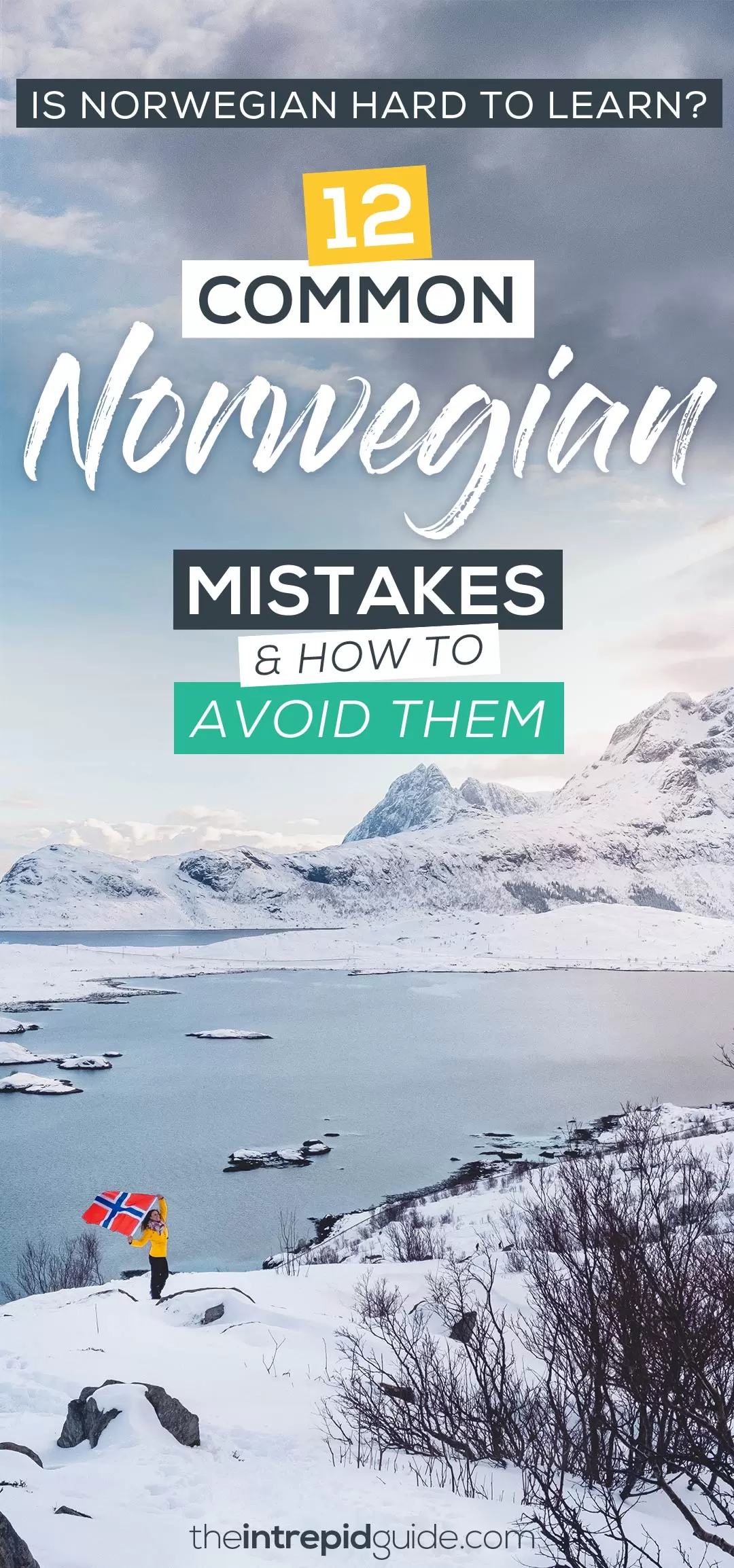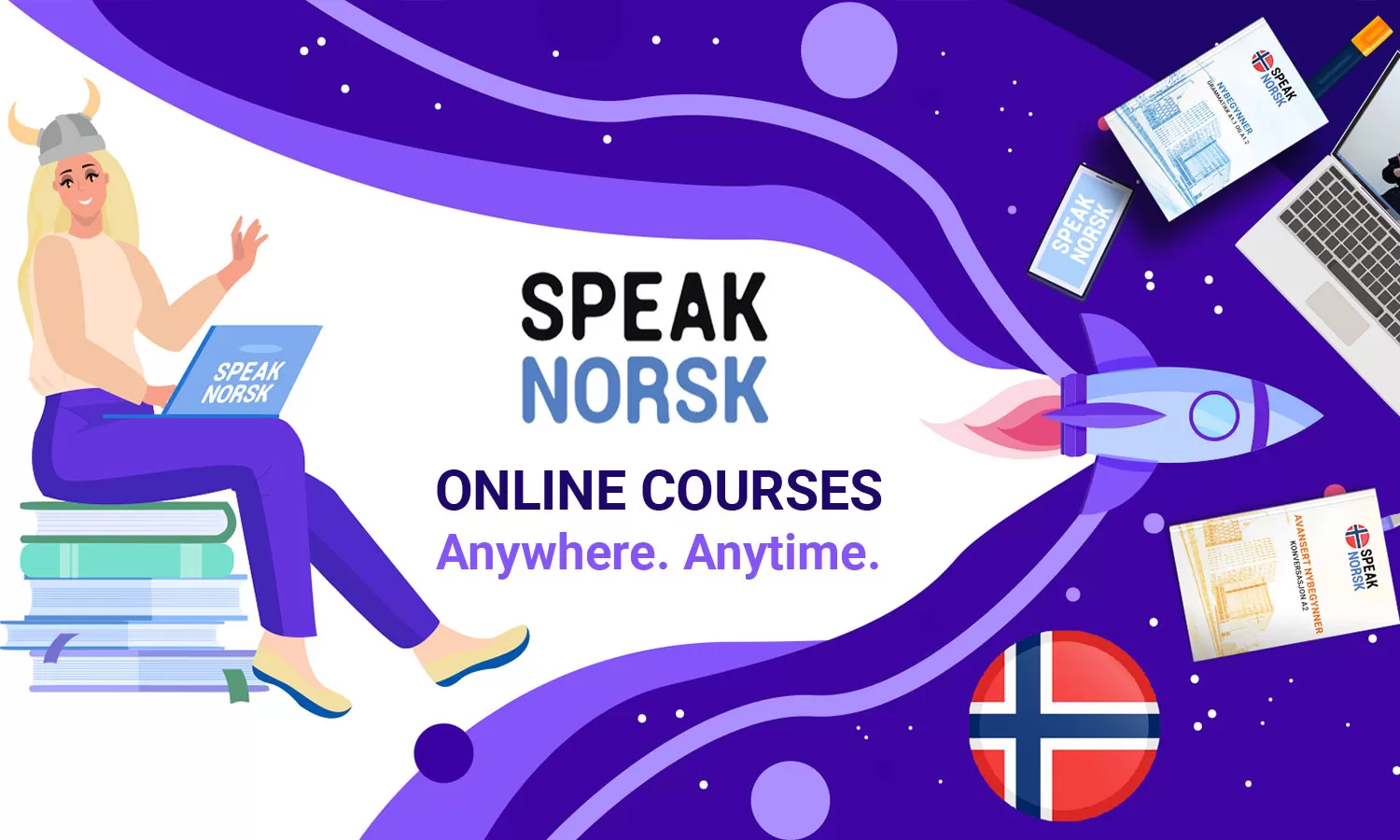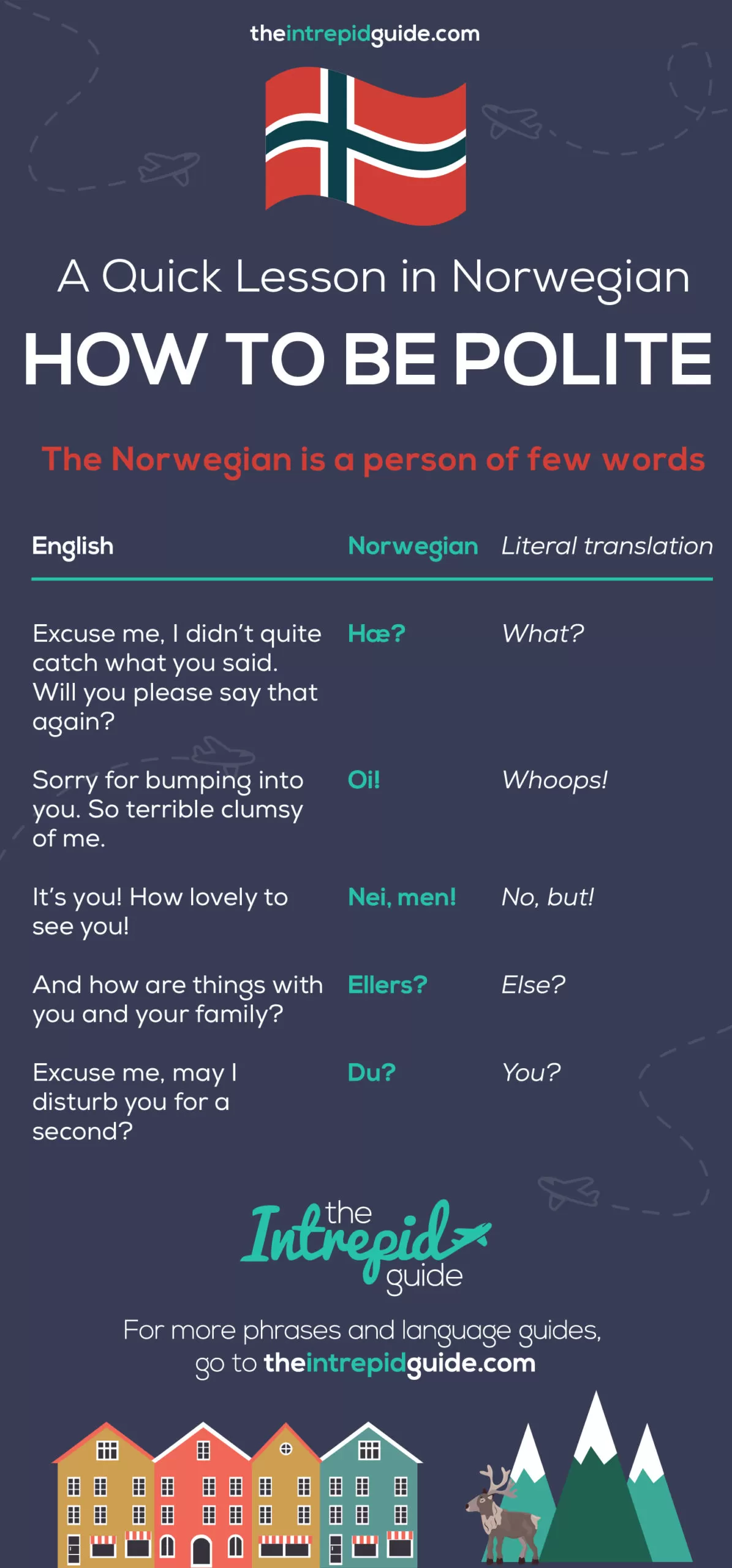Want to learn Norwegian? Is Norwegian Hard to Learn? Find out below plus how to avoid the 12 common Norwegian mistakes students make and get my top 11 language resources for learning Norwegian without wasting months of study.
Since I started learning Norwegian back in October 2018, I’ve learned a few linguistic quirks that I hadn’t come across when I studied other languages including Italian, French. Afrikaans and Arabic. Whilst learning Norwegian isn’t the most difficult language out there, there is definitely a small collection of common pitfalls that English speaking students tend to struggle with. Myself included.
You already know some Norwegian
As a native English speaker, one of the things I was most surprised to discover is that there is an incredible amount of words that are almost identical to English. These entered the English language via Old Norse.
Old Norse was spoken by the inhabitants of Scandinavia and the Vikings between the 9th and 13th centuries. From Old Norse came modern Icelandic, Faroese, Norwegian, Danish, and Swedish.
Before the Normans arrived in England, speakers of Old English and Scandinavian speakers lived in separate parts of the country. Eventually, these two groups merged and so did their languages. Out of this came Middle English – the predecessor of Modern English.
It was during this merging of languages that Old English adopted countless day-to-day words from Old Norse. These include: anger, awe, bag, band, big, birth, both, bull, cake, call, cast, cosy, cross, die, dirt, dream, egg, fellow, flat, gain, get, gift, give, guess, guest, hug, husband, ill, kid, law, leg, lift, likely, link, loan, loose, low, mistake, odd, race, raise, root, rotten, same, seat, seem, sister, skill, skin, skirt, sky, steak, though, thrive, Thursday, tight, till, trust, ugly, want, weak, window, wing, and wrong. Just to name a few.
Not to mention words such as:
- velkommen – welcome
- til – to (think ’till’)
- over – over
- språk – language (think ‘speak’)
- skrive – write (skrives means ‘is written’, think ‘scribe’)
- av – of
- frivillige – volunteer (think ‘free-willing’)
- fra – from
- verden – the world (verden – world)
- vindu – Window (vind-auga or “wind-eye” something wind-shielding)
- mann – Husband (hus-bonda – house-farmer or house-boss)
- lov – Law (same word with almost no alteration)
- rutine – routine
- gress – grass
- eksistere – exist
- bakgrunn – background
- kompliment – compliment
In the sentence, He took the knife and cut the steak. Only he, the and and come from Old English.
After 6 months of studying Norwegian, I also noticed how English-like Norwegian sentences can sound. I shared some of these this video of my progress.
Since then, I started a list of other Norwegian words and phrases which sound almost identical to English – just badly pronounced. Here are a few sentences to test for yourself. Say these out loud and see if you can guess their meaning (Check your answers at the bottom of the article).
- Kan du åpne opp døren?
- La meg se
- La oss holde kontakten
- Hvor ofte jobber du?
Do you want to learn Norwegian? Get 20% OFF SpeakNorsk. You won’t find this discount anywhere else. To claim this offer, all you have to do is click here and apply Promo Code: MOFF20 at the checkout!
12 Common Mistakes Norwegian Students Make & How to Avoid them
While vocabulary is certainly easy to pick up, here are the most common Norwegian mistakes English speakers make.
1. Word order: The verb comes second
Norwegian follows a pretty strict pattern when it comes to word order and it isn’t always the same as in English. These differences in word order are one of the most challenging to overcome initially but becomes easier with practice.
On the plus side, even if you do muddle up the word order, it won’t change the meaning or cause confusion.
For example, an English speaker will tend to say something like *Nå jeg bor i Oslo (Now, I live in Oslo) or *i dag det er kaldt (Today, it is cold). While this is perfectly correct in English, it’s grammatically incorrect in Norwegian. This is because Norwegian is a V2 language (verb-second), which means the verb will be in the second position in a statement.
Therefore, it’s correct Norwegian to say:
- Jeg bor i Oslo nå – I live in Oslo now
- Nå bor jeg i Oslo – Now I live in Oslo
- Det er kaldt i dag – It is cold today
- I dag er det kaldt – Today it is cold
- Min far besøker meg hver sommer – My father visits me every summer
- Hver sommer besøker min far meg – Every summer, my father visits me
No matter how you phrase your statement, the verbs always comes second.
2. Use the infinitive verb after modal verbs
Modal verbs are some of the most important and powerful verbs to learn to use, especially for beginners. Modals verbs indicate modality, in other words: likelihood, ability, permission, request, capacity, suggestions, order, obligation, or advice. Common English modal verbs are can, could, may, might, must, will, would, shall, should, ought to, had better, “have to” and sometimes need or dare.
Grammatically speaking, modal verbs are always followed but the full verb (infinitive) eg. (to) eat, (to) go, (to) run, (to) travel. Put together, a phrase using a modal verb would look like this:
- I might go to Tromsø for Christmas
- You must try kvikk lunsj
- He might stay in Norway
- We should learn Norwegian
Modal verbs are in bold and the full verb is underlined
In Norwegian, modal verbs include: skulle (should), skal (shall), ville (would), vil (will), måte (had to), må (must), kunne (could), kan (can). The main verb that follows a modal verb should be without the infinitive å marker.
English students tend to incorrectly use the present tense and say:
*Jeg må skriver et brev → Jeg må skrive et brev – I must write a letter
*Vi ville lærer norsk → Vi ville lære norsk – We wanted to learn Norwegian
3. There’s no -ing in Norwegian
Just like Italian, French, Finnish and many other languages, Norwegian does not have a progressive verb form like in English. For example, She is reading, we are coming.
In Norwegian, there is no am -ing, is -ing or are -ing. Instead, the present and past tense are used to express these ongoing events.
*Han er spiser → Han spiser – He is eating
*Jeg var leser → Jeg leste – I was reading
Norwegian also doesn’t use the present participle of a verb to express an ongoing activity. In other words, it doesn’t add -ing to the base form of a verb to create the present participle.
*De er skrivende → De skriver – They are writing
Common ways to express the English -ing is to:
1. Use the simple present or past tense
Vi lager mat – We are cooking/making food
Vi laget mat – We were cooking/making food
2. Use verbs that indicate position such as sitte (sit), ligge (lie down), stå (stand)
These verbs are used with the main verb and must be in the same tense and are connected using og (and).
Stine sitter og strikker en genser – Stine is (sitting and) knitting a sweater
Stine satt og strikket en genser – Stine was (sitting and) knitting a sweater
3. Use the expression holde på med å
holde på med å means “continue” or “is about to.”
Lisa holder på med å spise middag – Lisa is (continuing) eating dinner
4. Don’t forget to conjugate the verb
English speakers often forget to conjugate the finite verb which is essential in order to communicate effectively and correctly.
In Norwegian, there is a clear distinction between the full verb (infinitive) (snakke – talk) and the present tense (snakker → jeg snakker – I talk/am talking).
English speakers have to consciously remember that unlike in English where the first and second person forms are identical (I speak, you speak, we speak, they speak) to the infinitive speak, this isn’t the case in Norwegian.
*Vi snakke norsk hver dag → Vi snakker norsk hver dag – We speak Norwegian every day
Snakker = present tense
Jeg liker å gå på tur – I like to go walking
å gå = infinitive verb
5. Du/Deg/Dere: How to say ‘you’
It’s not until you study a language like Norwegian and that you learn just how simple English grammar is.
One of my favourite language learning quotes is:
You can never understand one language until you understand at least two. ‒ Geoffrey Willans
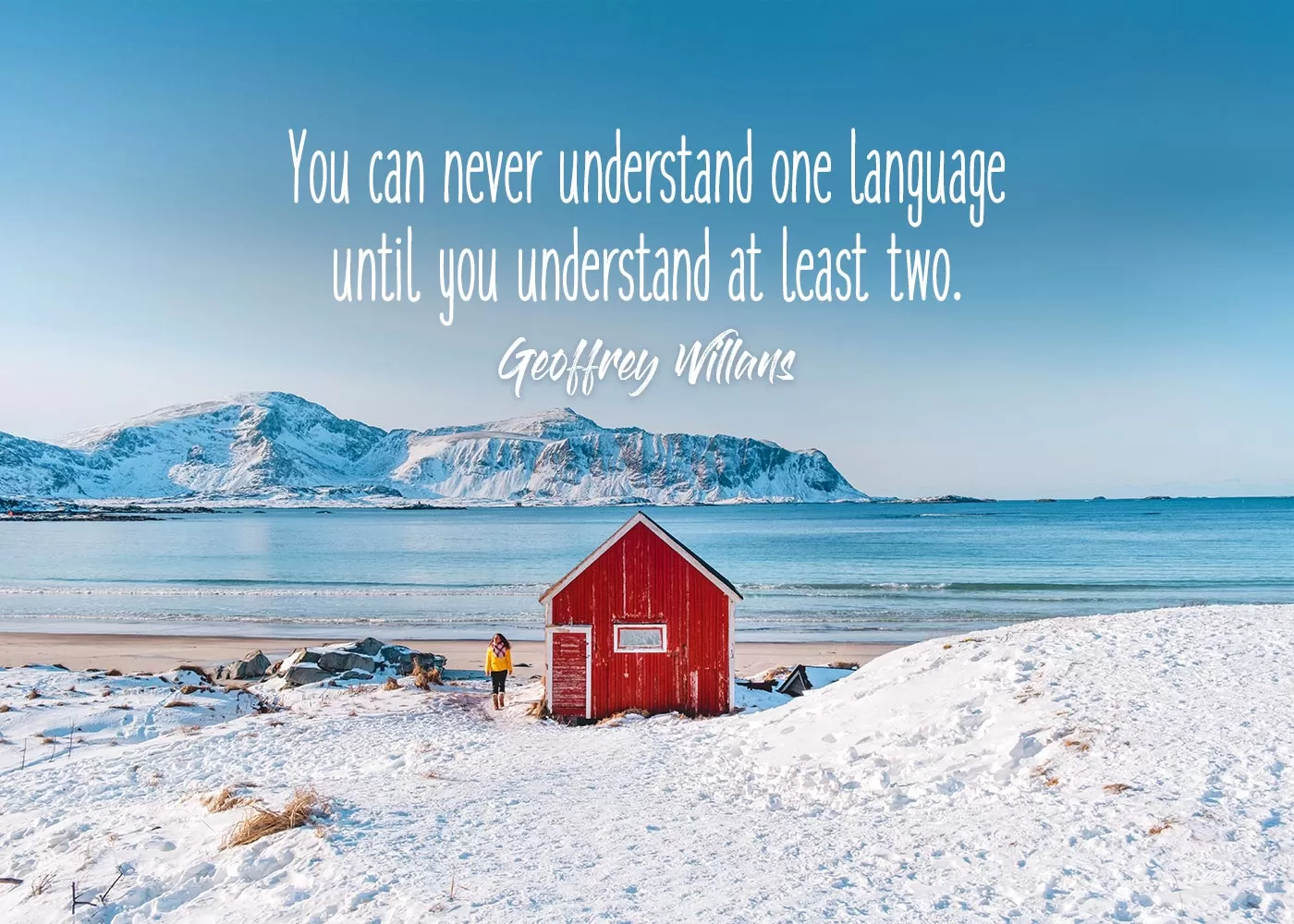
When it comes to English subject and object pronouns, we’ve kept things really simple and just have ‘you’. ‘You’ in the singular and ‘you’ in the plural. Or if you’re from southern states of America, ‘ya’ll’.
Norwegian, on the other hand, has a different word for every kind of ‘you’.
Subject: Du kommer fra Bergen – You come from Bergen
Object: Jeg liker deg – I like you
Plural Subject: Dere kommer fra Bergen – You (all) come from Bergen
Plural Object: Jeg forstår dere ikke – I don’t understand you
Note how the plural subject and plural object are the same – dere.
6. ‘The’ goes at the end of a noun
One of the trickiest things for an English brain to grasp is how Norwegian hooks the definite article ‘the’ onto the end of a noun. So, instead of saying, *Det hus, det (the) become a suffix that you tack onto the end and get huset (the house).
*den bil → bilen – the car (masculine)
*de dør → døra – the door (feminine)
*det treet → treet – the tree (neutral)
7. Som/At/Hvem/Det: Four ways to say ‘that’
This is another case where English uses one word that can be used in many different ways. This time, Norwegian has four words that all mean ‘that’, but unlike English, can’t be used interchangeably. Each has its own specific usage. Which, if I’m honest, I’m still getting used to! But, I am improving. I still have to consciously think about what I’m saying before making the correct choice when I speak Norwegian.
Som is used to connect a noun or pronoun with an additional clause that is a piece of related information.
Han er en mann som jeg kjenner – He is a man that I know
not
*Han er en man at jeg kjenner
At is used after a verb to connect it to a following clause.
Jeg vet at det er torsdag i dag – I know that it is Thursday today
Jeg tror at han heter Ivar – I think that his name is Ivar
not
*Jeg vet som det er mandag i dag*
Jeg synes som han heter Ivar
Hvem means ‘who’ or ‘whom.’
Hvem er du sammen med? – Who are you with?
not
*Jeg kjenner en kvinne hvem heter Astrid
When hvem is the subject in a relative clause, it is followed by som:
Jeg så ikke hvem som snakket – I didn’t see who was talking
8. Hvor vs. Hvordan: How to say ‘how’
As we’ve already seen, English keeps things simple with just one word to say ‘how’. In Norwegian, hvor is used before an adjective or an adverb while hvordan is used before a verb.
With adjective and adverb
Hvor lenge har du bodd i Norge? – How long have you lived in Norway?
Hvor langt er det til Stavanger? – How far is it to Stavanger?
Hvor mange elever er i klassen? – How many students are in the class?
not
*Hvordan lenge har du bodd i Norge?*
Hvordan langt er det til Stavanger? *
Hvordan mange elever er i klassen?
With verb
Hvordan går det? – How’s it going?
Hvordan staver du det? – How do you spell it?
9. Da / Når / Så – How do say ‘when’ and ‘then’
The Norwegian word da, can be both a conjunction to mean when and an adverb then. To understand the correct meaning, you must look at the word order of the sentence. As a general rule, it’s helpful to remember that da is only used to refer to events in the past.
Da telefonen ringte – When the telephone rang
(subject + finite verb means da is a conjunction)
Da ringte telefonen – Then the telephone rang
(finite verb + subject means da is an adverb)
Da jeg var ung, bodde jeg i Australia – When I was young, I lived in Australia.
Da hun fridde, sa han ja – When she proposed, he said yes.
Når is used when speaking about events that are happening now, in the future or whenever they were a repeated action in the past.
Når det var varmt, badet vi i elva – When it was hot, we bathed in the river
Når jeg får jobb, skal jeg flytte – When I get a job, I’ll move.
Så is a versatile word with many meanings.
1. Så as an adverb means then, afterwards, subsequently
Etter lunsj dro vi til Akershus festning. Så gikk vi til Rådhuset – After lunch we went to Akershus fortress. Then we went to the City Hall.
2. When placed in front of an adjective, så means so, very
Det var så interessant på Vikingskipshuset – It was so interesting at the Viking Ship Museum.
3. When used as a conjunction, så means so, for that reason, so that
Peter har ikke møtt Stines familie før, så han er litt nervøs – Peter has not met Stine’s family before, so he is a bit nervous.
4. Så also means saw was is the past participle of the verb å se (to see):
Vi så ham på TV i går kveld – We saw him on TV last night
10. Tenke / Tror / Synes – How to ‘think’ in Norwegian
Very early on in my Norwegian studies I discovered that Norwegians ‘think’ differently – and they have 3 very different words for it too! Tenke, tror, and synes. Knowing which one to use comes down to context and what you’re thinking about.
Synes is used when the speaker has personally experienced something and has formed their own opinion of it. Therefore synes is only used to express a subjective opinion to express personal likes and dislikes. Synes could also be translated as “to be of the opinion that”
Jeg synes filmen var spennede – I think the film was exciting (I saw it, and I found it exciting)
Jeg synes vinteren er flott – I think the winter is wonderful
Jeg synes de er flinke – I think they’re good
Tror can also be used to express an opinion when the speaker does not or can know all the facts about something, but they can check them. For example, if you tror tomorrow will be sunny, or that Norway has a population of 5 million, in both cases you can check (often by Googling) if you’re correct.
Jeg tror det blir sol i morgen – I think tomorrow will be sunny
Vi tror at Norge har en befolkning på 5 millioner – We think that Norway has a population of 5 million.
Tenke, which sounds just like the English ‘think’, is the easiest to remember because it’s used to describe brain activity. For example, you think about your boyfriend.
Jeg skal tenke på det – I´ll think about it
Norwegian’s also use tenke when they plan to do something.
Jeg har tenkt å gjøre det neste uke – I have planned to do next week
Vi har tenkt å tå en tur til Grønland – We have thought about (considered) taking a trip to Greenland
11. Gang / tid / time – How to say ‘time’
Time is another word which trips up English speakers since there are 3 very distinct uses for it in Norwegian.
Time, which is spelled exactly the same way in Norwegian, means hour, and timer (hours).
Jeg har ventet i en time – I have waited for an hour
Gang means time in the sense of one time or occasion. En gang (one time or once), and to ganger (two times or twice).
Jeg var i Norge en gang for mange år siden – I was in Norway once (one time) many years ago
Det var en gang et troll – Once upon a time, there was a troll.
To express the concept of time, use tid. This expresses the English equivalent of time period, passage of time and epoch.
Jeg har god tid – I have more time
Hun hadde ikke tid – She didn’t have time
Jeg kan ikke snakke nå fordi jeg har dårlig tid – I can’t talk now because I don’t have time
Vi snakker norsk hele tiden – We speak Norwegian all the time
12. Pronouncing long and short vowels
Norwegian is a phonetic language, but English speakers often forget that Norwegian has long and short vowels which can cause all sorts of confusion or at the very least, a few giggles.
For example, the vowel in tak (roof ceiling) should be pronounced long i.e. taahk. Whilst the vowel in takk (thank you) is short and should be pronounced short i.e. tahk.
As a general rule, wherever there is a double consonant, the vowel is short.
Mine (my/mine) is pronounced long but minne (remind) is pronounced short.
Is Norwegian Hard to Learn?
The short answer: No, not really. Norwegian is considered one of the easiest languages for English speakers to learn because English has at least 5,000 loan words from Old Norse, and shares the same word order, grammar and syntax as Norwegian. However, what English speakers will struggle with are the 12 common pitfalls outlined above.
For those of you whose native language is either Danish, Dutch, German, or Swedish, then you’ll find learning Norwegian significantly easier to understand and to learn. In fact, Norwegian, Danish and Swedish are all mutually intelligible thanks to their common linguistic roots. I discuss this topic in further detail in my Norwegian travel phrase guide here.
The Many Dialects of Norway
Whilst Norwegian is ‘easy’ to learn to read, write and speak, understanding it can be a hurdle in itself. Thanks to Norway’s mountainous landscape, this created a lot of geographical and linguistic isolation over the centuries which has seen countless dialects emerge. As such, there is no standard spoken Norwegian. It is totally normal and accepted to use your local dialect whatever the context or situation. Even politicians and news reporters do this.
Just like there is no one way of speaking Norwegian there are also two official variations of written Norwegian. Known as Bokmål (literally “book tongue”) and Nynorsk (“new Norwegian”), the difference between the two is small but still important.
So, if you learn Bokmål which is predominantly used in Oslo and in two-thirds of the country, as you move around Norway, you might suddenly find yourself struggling to understand 60-70 % of what is being said to you.
How to learn Norwegian: Top 11 Best Resources for Learning Norwegian
To help me learn Norwegian, I’ve used and in most cases, am still using the following 11 Norwegian resources.
1. Start Norwegian
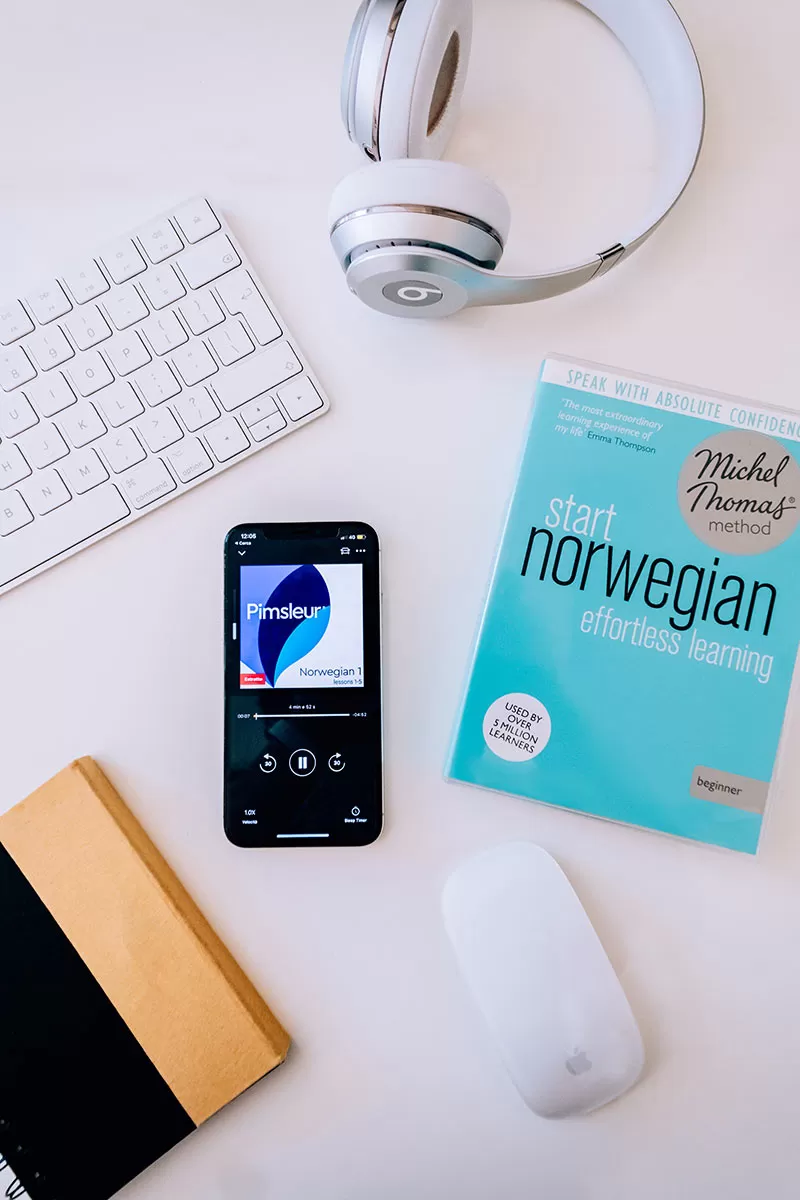 Start Norwegian is a Norwegian audio course for beginners and was the first Norwegian resource I picked up. I’m a huge fan of Michel Thomas courses so I knew this would be a great introduction to the languages to get me speaking quickly. I only wish there were more in the series. Nonetheless, it provides an excellent foundation. Get Start Norwegian here.
Start Norwegian is a Norwegian audio course for beginners and was the first Norwegian resource I picked up. I’m a huge fan of Michel Thomas courses so I knew this would be a great introduction to the languages to get me speaking quickly. I only wish there were more in the series. Nonetheless, it provides an excellent foundation. Get Start Norwegian here.
2. Norwegian – Verbs and Essentials of Grammar
This compact yet comprehensive grammar book is written in English and has fantastic explanations and examples. Get Norwegian – Verbs and Essentials of Grammar here.
3. Colloquial Norwegian
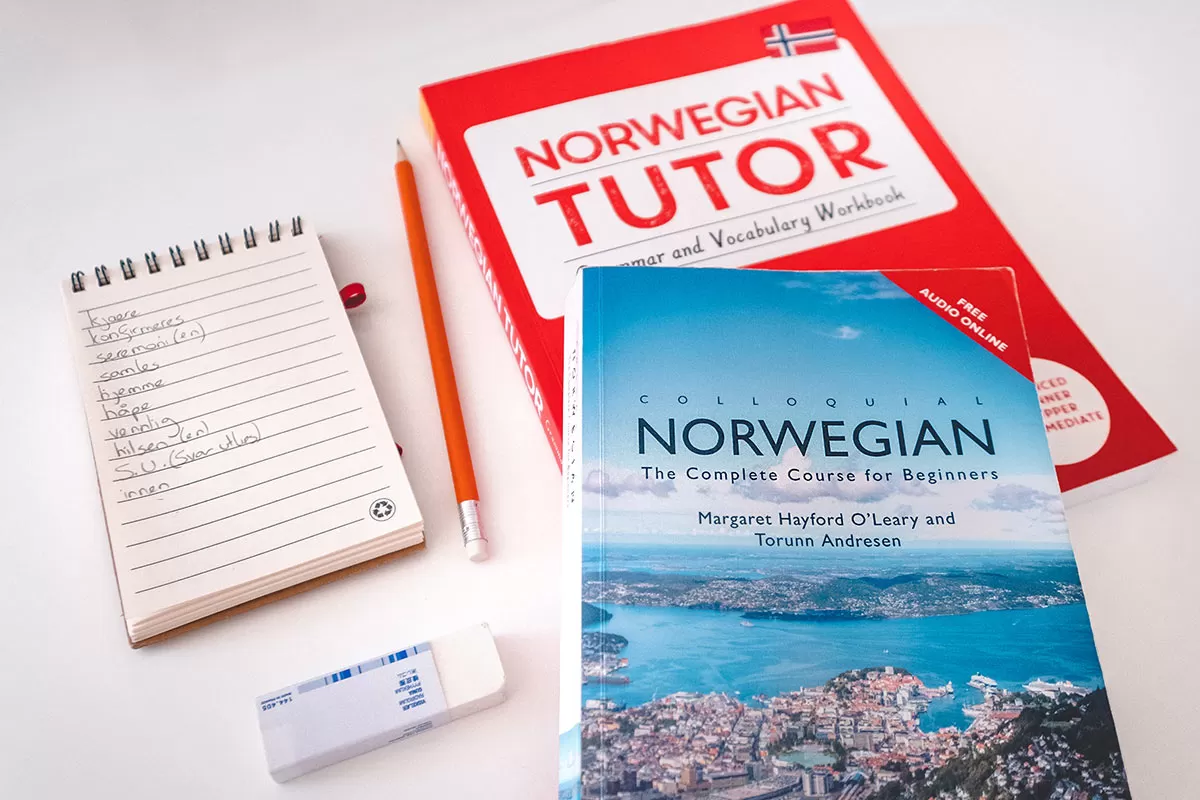 This was the first Norwegian book I used and what we used as our class textbook at Cactus Language school. I’ve only just recently finished this book which took me from absolute beginner to intermediate. The book includes free audio which is available online to stream or download from www.routledge.com. The audio features a variety of native accents from all over the country, so you’ll be exposed to them from day one. Get Colloquial Norwegian here.
This was the first Norwegian book I used and what we used as our class textbook at Cactus Language school. I’ve only just recently finished this book which took me from absolute beginner to intermediate. The book includes free audio which is available online to stream or download from www.routledge.com. The audio features a variety of native accents from all over the country, so you’ll be exposed to them from day one. Get Colloquial Norwegian here.
4. Exploring Norwegian Grammar
This book is a bit trickier to get a hold of but if you can, I highly recommend it! I had to buy mine in Norway but I’ve more recently discovered it here on Barnes & Noble. This book is so fun to read and digest. The examples are funny which makes them memorable and the overall tone of the book is very lighthearted yet super helpful. They also have an online quiz where you can test yourself after each chapter. You ca
5. The Mystery of Nils. Part 1 (A1-A2)
Perhaps the most loved Norwegian textbook is this story-based text. Written in Norwegian with grammar explanations in English, the Norwegian language is slowly revealed to you through following the story of Nils with supporting exercises to help reinforce your learning. Once you reach intermediate Norwegian, you can then move on to its second installation Mysteries om Nils for B1-B2 students. Get The Mystery of Nils. Part 1 (A1-A2) here. They even have online courses for the books which you can join here.
6. Short Stories in Norwegian
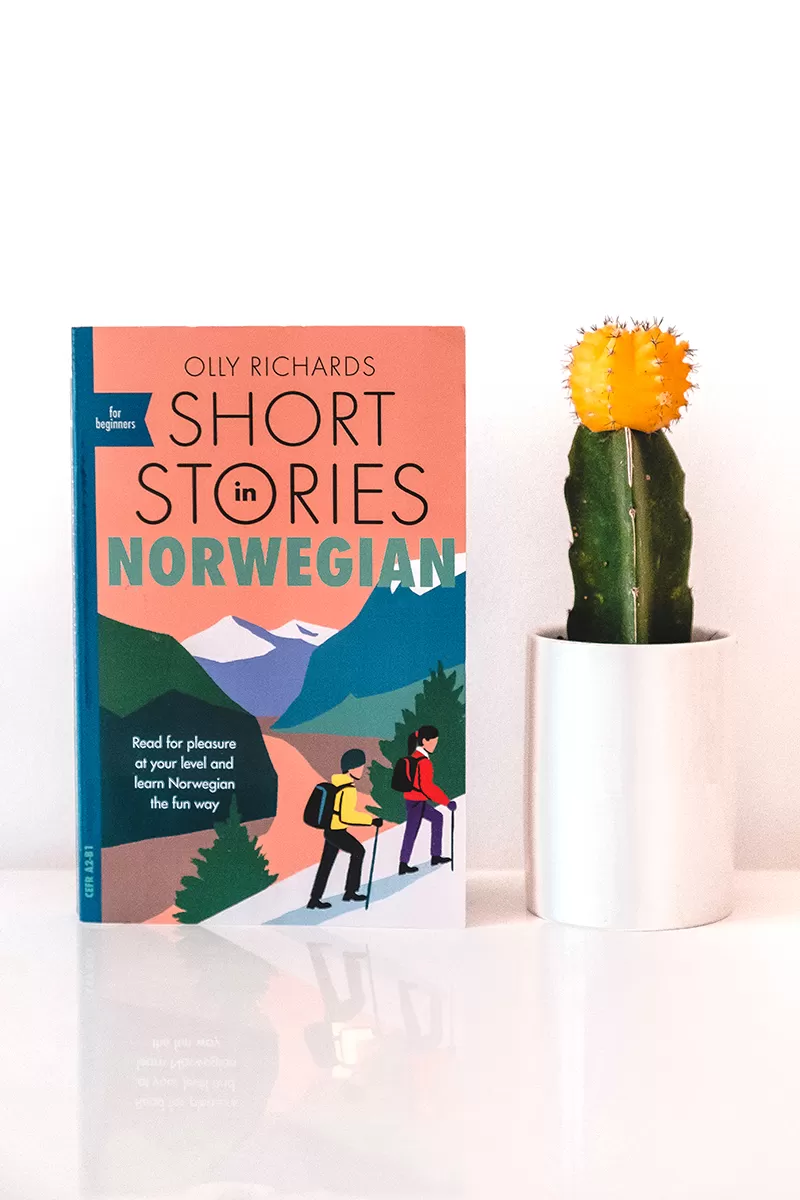 One of the challenges for language learners is finding reading material that is both interesting but not so complex that you need to constantly check a dictionary. There’s nothing worse than purchasing a book you’re excited about only to never finish reading it because “it’s too hard!” I started reading Short Stories in Norwegian for Beginners. I‘m enjoying it so much that I’m taking my time reading it because I don’t want it to end! The Short Stories series is targeted to high-beginner to low-intermediate level learners. Each book includes 8 stories covering a variety of topics from science fiction and crime to history and thriller, which means you’re exposed to a wide range of new vocabulary. What I love about the Short Stories series is that you feel a real sense of achievement. Chapters are kept short and sentences are simple and not too wordy. New words are highlighted in bold and included in a short glossary at the end of the chapter so you don’t need to rely on a dictionary. There is even a fun comprehension quiz after each chapter to see how well you understood the text. It’s also important to note that the stores are mapped to A2-B1 Common European Framework of Reference (CEFR) for languages, which means it’s the perfect study companion alongside your other language learning resources. Get Short Stories in Norwegian for Beginners here
One of the challenges for language learners is finding reading material that is both interesting but not so complex that you need to constantly check a dictionary. There’s nothing worse than purchasing a book you’re excited about only to never finish reading it because “it’s too hard!” I started reading Short Stories in Norwegian for Beginners. I‘m enjoying it so much that I’m taking my time reading it because I don’t want it to end! The Short Stories series is targeted to high-beginner to low-intermediate level learners. Each book includes 8 stories covering a variety of topics from science fiction and crime to history and thriller, which means you’re exposed to a wide range of new vocabulary. What I love about the Short Stories series is that you feel a real sense of achievement. Chapters are kept short and sentences are simple and not too wordy. New words are highlighted in bold and included in a short glossary at the end of the chapter so you don’t need to rely on a dictionary. There is even a fun comprehension quiz after each chapter to see how well you understood the text. It’s also important to note that the stores are mapped to A2-B1 Common European Framework of Reference (CEFR) for languages, which means it’s the perfect study companion alongside your other language learning resources. Get Short Stories in Norwegian for Beginners here
7. Norwegian Tutor
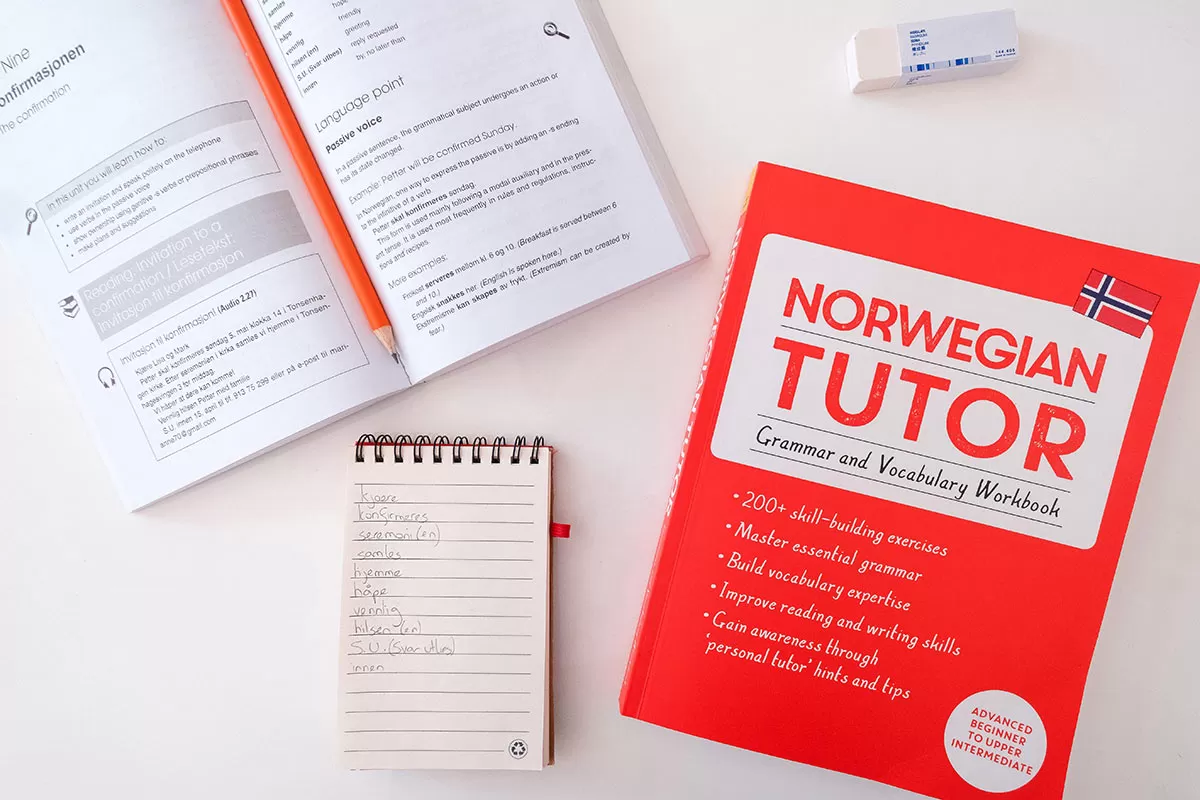 This workbook is excellent at helping you practise and reinforce what you’ve learned with over 200 exercises and activities which covers grammar and vocabulary. The exercises include visuals and infographics as well as language hints and tips to help you to understand language rules and culture points. Get Norwegian Tutor here.
This workbook is excellent at helping you practise and reinforce what you’ve learned with over 200 exercises and activities which covers grammar and vocabulary. The exercises include visuals and infographics as well as language hints and tips to help you to understand language rules and culture points. Get Norwegian Tutor here.
8. italki
I feel like italki is the secret weapon of the polyglot world. Literally, every linguist, polyglot, and language learner I know uses italki to connect with native speakers online to help then learn languages. italki allows learners to connect with both professional teachers for lessons and native speakers for more informal sessions. This is a very convenient way to learn and maintain your development as all sessions are run via Skype. Some teachers even offer a free trial. I have weekly italki lessons with Anita, from Ålesund and since starting, my confidence with the language and speaking still have dramatically improved because of our 1:1 interaction. I also use my lessons to go over any areas I’m struggling with or ask questions about things I’ve come across during the week that I want to clarify. Read my full italki review here and sign up to italki here.
9. Mondly
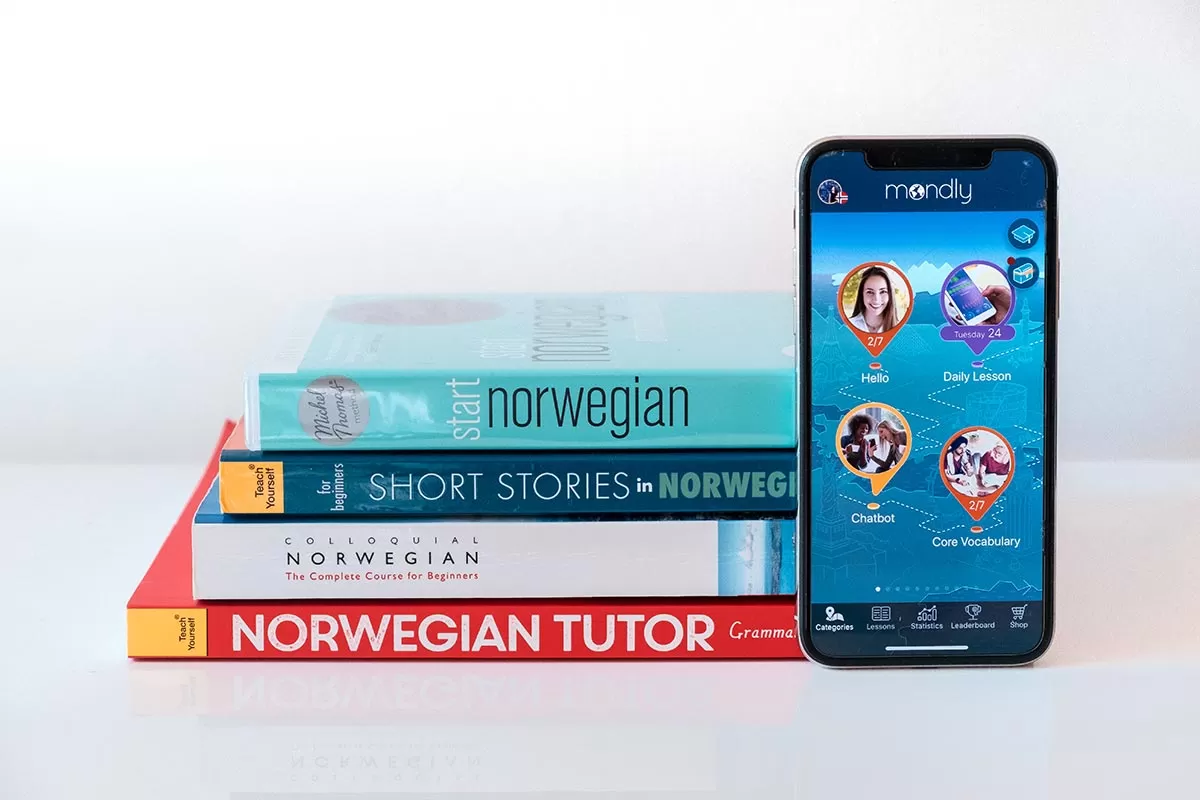 It’s no secret that I’ve been a fan of Mondly for years. Its ease of use, friendly interface, and variety of interactive lessons are super important to me. I’m currently using Mondly to learn Norwegian vocabulary with short bursts of fun and interactive lessons daily. One of the best features of Mondly’s app (which sets it apart from other apps) is that you can learn from your native language. That’s right, you don’t have to be a native English speaker to use the app. This feature is especially useful if you speak other foreign languages and want to keep them fresh while learning another language! They teach numerous languages which aren’t available on many other language learning apps, which is why Mondly is my favourite app of them all. The recently added Bengali, Catalan, Latin, Latvian, Lithuanian, Slovak, Tagalog and Urdu, bringing the total languages available with Mondly to 41! Click here to get 95% OFF Mondly’s Lifetime subscription using my special reader discount.
It’s no secret that I’ve been a fan of Mondly for years. Its ease of use, friendly interface, and variety of interactive lessons are super important to me. I’m currently using Mondly to learn Norwegian vocabulary with short bursts of fun and interactive lessons daily. One of the best features of Mondly’s app (which sets it apart from other apps) is that you can learn from your native language. That’s right, you don’t have to be a native English speaker to use the app. This feature is especially useful if you speak other foreign languages and want to keep them fresh while learning another language! They teach numerous languages which aren’t available on many other language learning apps, which is why Mondly is my favourite app of them all. The recently added Bengali, Catalan, Latin, Latvian, Lithuanian, Slovak, Tagalog and Urdu, bringing the total languages available with Mondly to 41! Click here to get 95% OFF Mondly’s Lifetime subscription using my special reader discount.
10. Join Intrepid Norwegian for Travel and learn with me
 Travelling to Norway? Go from clueless to confident in as little as two weeks with my course Intrepid Norwegian. Using Pareto’s 80/20 rule, you’ll learn the most powerful 20% of vocabulary needed to communicate in 80% of the situations you’ll find yourself in whilst travelling. What does this mean? It means you will skyrocket your understanding of the language and get you to a basic conversational level. You have lifetime access to all of the training material, so you can either go through the content all at once or you can slow things down and go at your own pace. It’s totally up to you! To find out more visit Intrepid Languages courses here and my new course Intrepid Norwegian here.
Travelling to Norway? Go from clueless to confident in as little as two weeks with my course Intrepid Norwegian. Using Pareto’s 80/20 rule, you’ll learn the most powerful 20% of vocabulary needed to communicate in 80% of the situations you’ll find yourself in whilst travelling. What does this mean? It means you will skyrocket your understanding of the language and get you to a basic conversational level. You have lifetime access to all of the training material, so you can either go through the content all at once or you can slow things down and go at your own pace. It’s totally up to you! To find out more visit Intrepid Languages courses here and my new course Intrepid Norwegian here.
Here’s what my students are saying:

It certainly exceeded my expectations. The learning methodology is great, and easy to follow and found that I progressed much faster in the last 4 weeks than I ever did on my own or using other language apps. – Roma Small
Click here for instant access!
11. Go from Absolute Beginner to an Upper-Intermediate speaker with Speak Norsk (Exclusive reader discount)
For the most complete and comprehensive way to learn Norwegian, you can’t pass up Speak Norsk, the highest-rated Norwegian language school in Norway. Speak Norsk are the absolute leaders and the best option on the market if you’re serious about reaching a high level in Norwegian. They offer a complete pathway so you can go from absolute beginner (A0-A2) to intermediate (B1-B2) and advanced (C1-C2). Speak Norsk have both a physical language school based in Oslo and offer a series of engaging online self-paced video courses so you can learn anytime, anywhere from the comfort of your home and around your own busy schedule.
Speak Norsk offer tonnes of courses, but my personal favourite and the best value for money is their Viking for Beginners package. This includes access to:
- 9 complete courses – Including A0, A1.1, A1.2, A2.1, A2.2, B1.1, B1.2, B2.1 and B2.2
- Teacher guidance available 24/7 with native-speaking, qualified teachers
- Pre-recorded grammar lessons
- Grammar exercises and quizzes
- Pre-recorded pronunciation lessons
- Pre-recorded conversation lessons (Including texts, vocabulary, and listening exercises)
- Vocabulary lists
- Repetition exercises and grammar overview videos – This is great to review the previously material and topics
- Motivational videos from their most-popular teachers
- Mid-term and final term evaluations for each level
- Continuous support and guidance from Speak Norsk administration and teachers on your learning journey
- BONUS: Access previously recorded live classes – This includes grammar lessons and exercise-solving videos
***Exclusive Reader Discount. GET 20% OFF!
As a huge fan of Speak Norsk, I asked their team for a special discount code so you can get 20% off their popular Viking for Beginners Package. You won’t find this discount anywhere else. To claim this offer, all you have to do is click here and apply Promo Code: MOFF20 at the checkout! Happy learning!
Answers to the Norwegian phrases from above
- Can you open the door?
- Let me see
- Let’s keep in touch
- How often do you work?
How many did you get right? Let me know in the comments!
Travelling to Norway? Then you should learn these top 10 Norwegian phrases
Over to you!
Are you learning Norwegian? Which of these common Norwegian mistakes do you make? What would you add to this list? Let me know using the comments section below or join me on social media to start a conversation.
Thanks for reading and I hope you enjoyed this post.
Like what you see? Subscribe using the form below to have all of my posts delivered directly to your email.
Learning Norwegian? Don’t miss these
- 49 Hilarious Norwegian Idioms and Sayings That Will Make You Giggle
- Survival Norwegian Travel Phrase Guide with Pronunciation
Want to know more about learning languages? Start here!
- 6 Language Learning Tips: How to Learn a Language from Home
- What Type of Language Learner Are You? Your 4-Step Personalised Learning Plan
- 20 Top Language Learning Resources You Should Use
- 44 Best Movies on Disney Plus for Learning Languages
- 13 Ways to Seamlessly Integrate Language Learning into Your Daily Life
- 10 Pro Tips: How to Learn a Language with a Full-Time Job
- 7 Reasons Why You Should Go on a Language Holiday
- Essential Travel Phrases: How to be Travel Fluent in 10 Simple Steps
- 23 Cool Gift for Language Learners They Will Actually Use and Love
- How to Learn Your First Foreign Language in 8 Simple Steps: A Beginner’s Guide
- 11 Life-Changing Reasons Why You Should Learn a Language
- 42 beautiful Inspirational Quotes for Language Learners
- Language learning tips: 11 Polyglots Reveal The Secrets of Their Success
- Top 10 Best Ways to Learn a Language Better and Faster
- How Many Languages are there in the World?
Like it? Pin it for later
